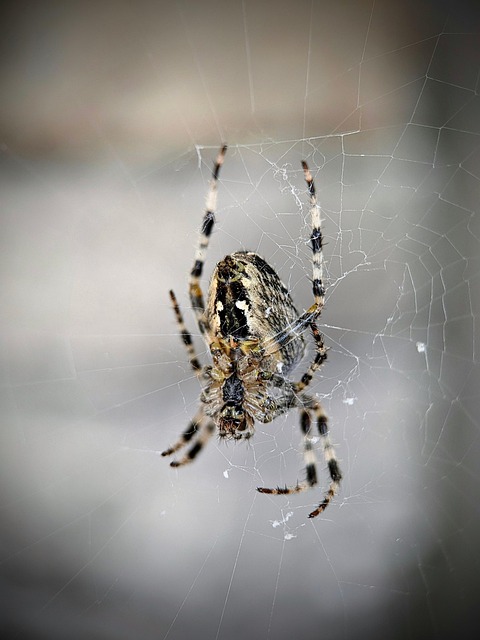Spiders can be kept at bay through a multi-pronged approach to spider-proofing your home. This involves eliminating hiding spots by regularly cleaning and decluttering, sealing entry points with caulk or weatherstripping, using natural repellents like lavender and mint, vacuuming thoroughly, and strategically placing plants around the perimeter. Combining these physical barriers with eco-conscious chemical applications, such as neem oil diluted in water, ensures long-term success in spider prevention while maintaining a healthier indoor environment for you and your family.
In many homes, spiders are an inevitable presence, but that doesn’t mean coexistence has to be uncomfortable or harmful. This guide explores humane and eco-conscious approaches to spider prevention, helping you spider-proof your home effectively while minimizing environmental impact. From understanding spider behavior and habitat to employing eco-friendly deterrents, creating a spider-free environment using safe chemicals, and adopting long-term strategies for sustainable spider control, these methods offer a comprehensive solution.
Understanding Spider Behavior and Habitat
Understanding Spider Behavior and Habitat
Spiders are arachnids that play a vital role in most ecosystems, serving as predators for insects and other small creatures. However, their presence inside homes can be unwelcome and unsettling for many people. To effectively spider-proof your home, it’s crucial to understand where they live and how they behave. Spiders are drawn to dark, tight spaces, such as cracks in walls, attics, cellars, and corners of rooms. They build webs as both a trap for prey and a way to rest and protect themselves. By eliminating potential hiding spots and regularly cleaning areas prone to spider activity, you can make your home less appealing to them.
Regular inspections are key to identifying entry points and signs of spider activity. Seal any cracks or gaps in doors, windows, and walls using caulk or weatherstripping. Vacuuming regularly, especially in corners and along baseboards, helps remove webs and eggs. Additionally, maintaining a clean and clutter-free home reduces potential food sources for spiders. Planting certain herbs like lavender, mint, and lemongrass around your property can also act as natural repellents due to their strong scents that spiders find unpleasant.
Eco-Friendly Methods to Deter Spiders
When it comes to spider prevention, there are numerous eco-friendly methods that can help you spider-proof your home without resorting to harsh chemicals. One effective strategy is to maintain a clean and clutter-free environment. Spiders are attracted to dark, narrow spaces and hiding places, so regularly decluttering and vacuuming can significantly reduce their appeal to your home. Additionally, sealing entry points like cracks, gaps in doors, and windows with caulk or weatherstripping can prevent spiders from finding their way indoors.
Plants known for their natural repellency towards spiders, such as lavender, citronella, and catnip, can be strategically placed around your home’s perimeter. Essential oils derived from these plants can be diffused or mixed with water and sprayed around entry points. Another clever approach is to use sticky traps made from non-toxic materials, which can effectively capture spiders without causing them harm. These methods not only promote a humane treatment of spiders but also contribute to maintaining a healthier indoor environment for you and your family.
Creating a Spider-Free Environment Using Safe Chemicals
Creating a spider-free environment involves a combination of physical barriers and safe, eco-conscious chemical applications. Start by identifying entry points such as cracks, gaps in walls, or poorly sealed doors and windows. Seal these openings using caulk or weatherstripping to prevent spiders from infiltrating your space. Regularly vacuum and dust, paying special attention to corners and dark spaces where spiders tend to hide.
When it comes to chemical treatments, opt for natural repellents like peppermint oil, lavender, or neem oil. These substances are known to deter spiders without causing harm to humans or pets. Dilute these essential oils with water and spray them around entry points, window sills, and areas where spiders are commonly spotted. Always follow the instructions on the product label and consider using them in conjunction with other spider-proofing methods for optimal results.
Long-Term Strategies for Sustaining Spider Prevention
To achieve long-term success in spider prevention, it’s essential to adopt a holistic approach that combines environmental modifications with strategic habits. One effective method is to focus on spider-proofing your home, ensuring every entry point is sealed off. This involves regularly inspecting and fixing gaps in doors, windows, and walls, as well as using physical barriers like screens and mesh covers. By making these adjustments, you significantly reduce the chances of spiders finding their way inside.
Additionally, maintaining a clean and clutter-free environment plays a crucial role. Regularly vacuuming or sweeping allows for the removal of webs and potential hiding spots. Using natural repellents like citrus oils or mint also shows promise in deterring spiders without resorting to harsh chemicals. These strategies not only keep your living spaces spider-free but contribute to a healthier, more eco-conscious home environment.
In summary, humane and eco-conscious approaches to spider prevention involve understanding their behavior and habitat, employing safe, non-toxic methods, and utilizing chemical alternatives responsibly. By implementing these strategies, you can effectively spider-proof your home while maintaining a healthy and balanced environment. Long-term sustainability lies in combining short-term solutions with permanent structural changes, ensuring a safe and comfortable living space for both humans and spiders.
